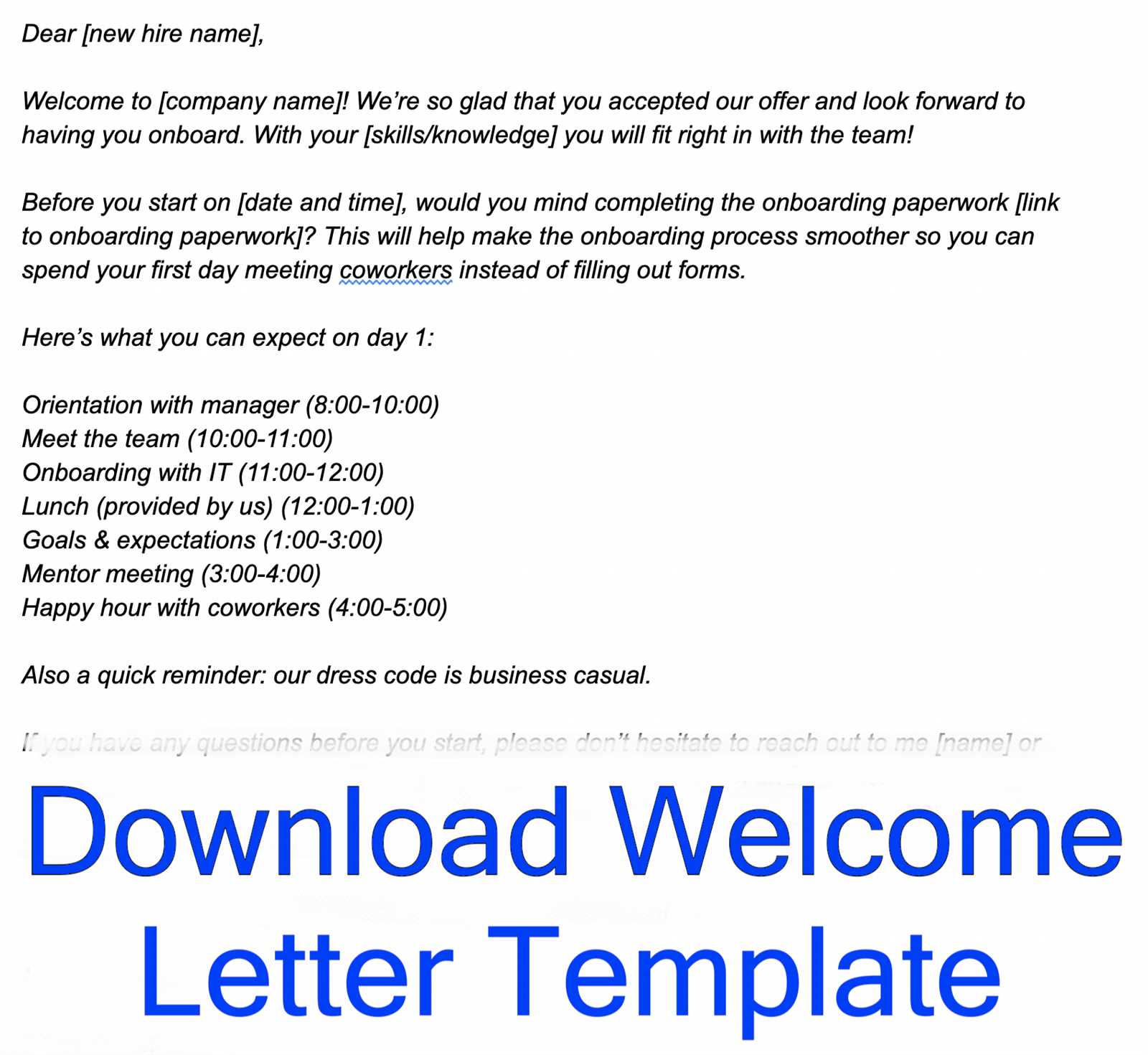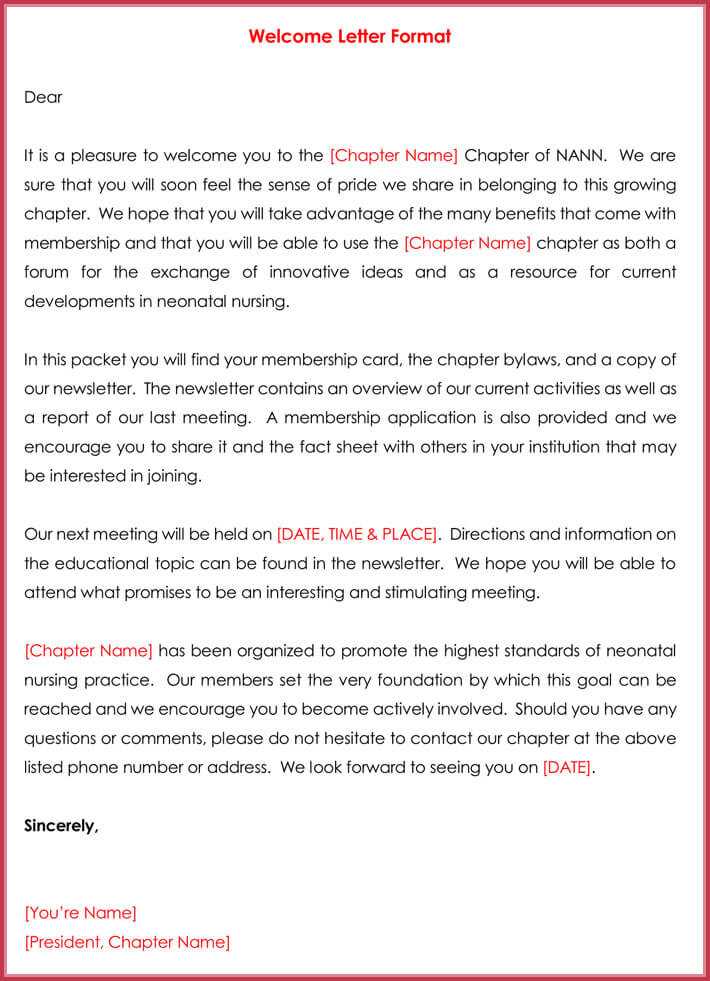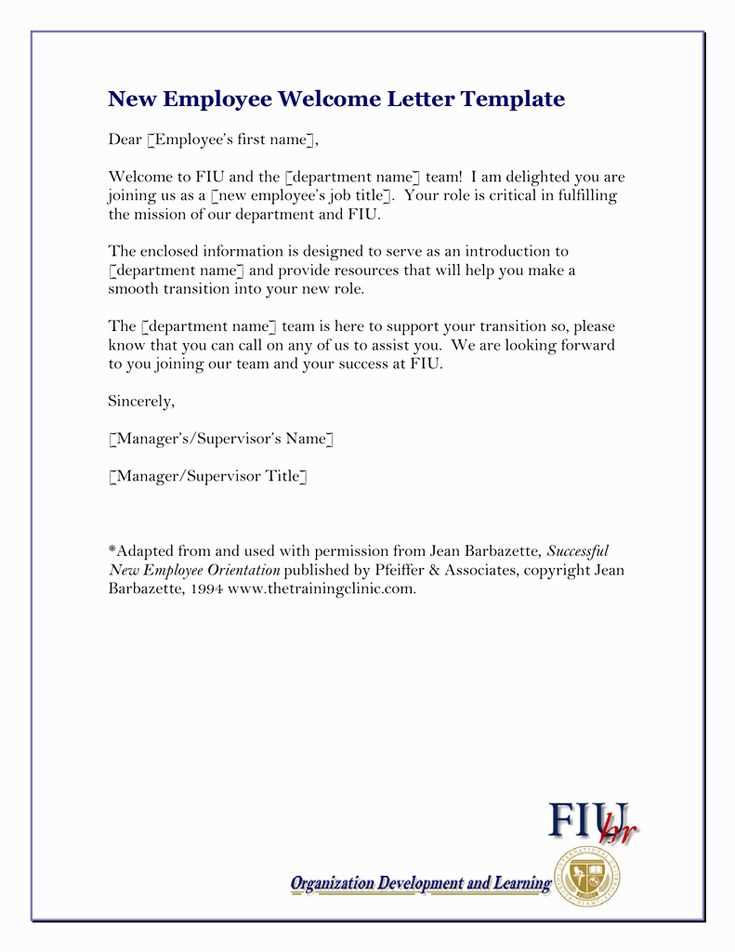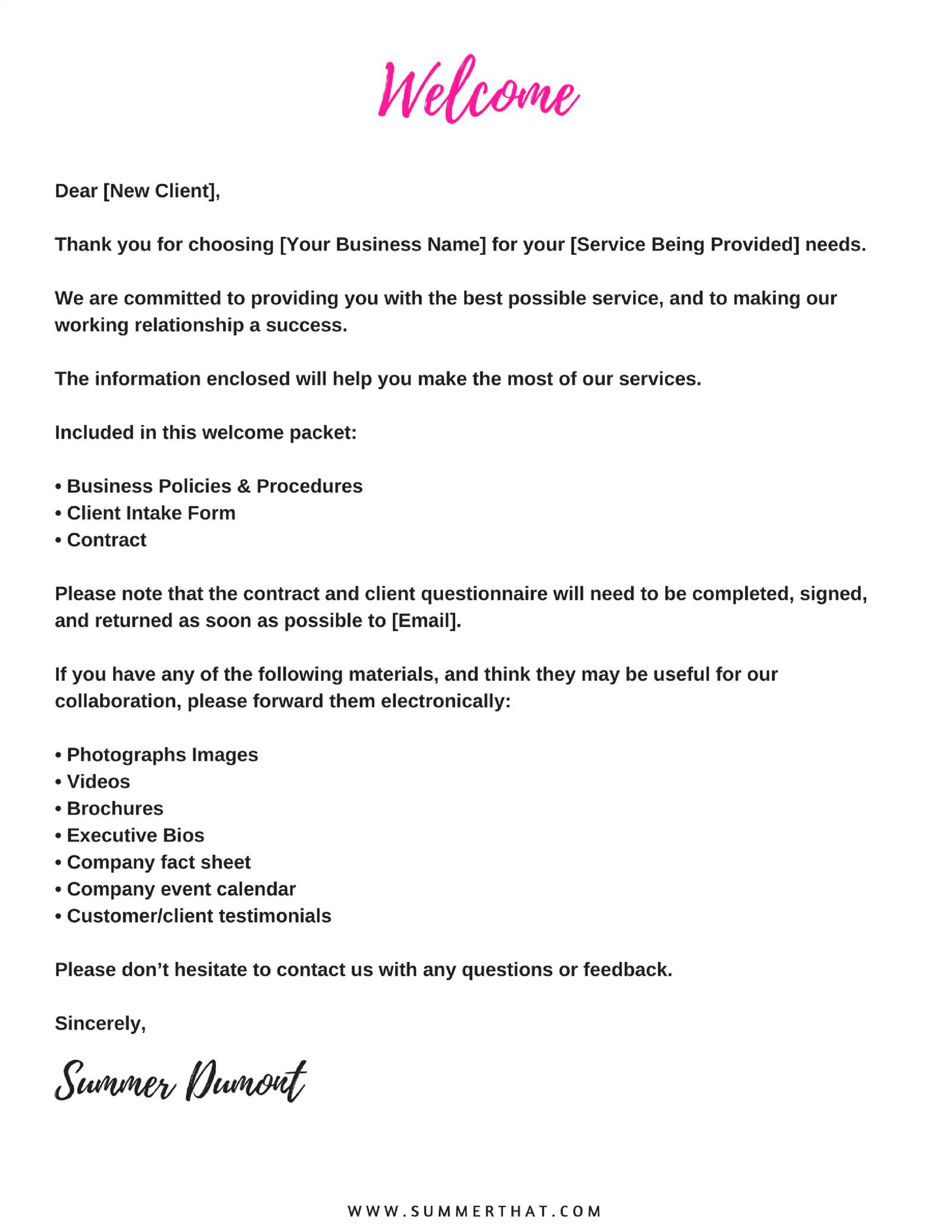Business Welcome Letter Template for New Clients

Establishing strong relationships right from the start is crucial for any organization. One of the best ways to set the right tone is by sending a thoughtful message to your first-time associates. This communication serves as the foundation for a positive collaboration and helps foster trust and professionalism from day one.
Crafting an impactful note requires attention to detail and an understanding of how to balance warmth and professionalism. It is important to convey appreciation for the partnership and express enthusiasm for the upcoming journey together. A well-written communication not only introduces your company’s values but also makes the recipient feel valued and welcomed.
Adapting the message to suit the specific needs and culture of the recipient is key. Whether it’s for a formal or more casual relationship, adjusting your tone and style will ensure that the communication feels genuine and tailored to the situation. The goal is to leave a lasting, positive impression that sets the stage for future interactions.
Effective Communication with New Partners
Creating a positive first impression is essential when forming a new professional relationship. A carefully crafted message at the outset sets the tone for future interactions and helps establish trust. This initial communication is an opportunity to showcase your company’s values, professionalism, and commitment to the collaboration ahead.
Key Elements to Include
- Personal Greeting: Address the recipient by name to make the message feel more personalized and engaging.
- Introduction: Briefly introduce your company and the role you play in the partnership.
- Express Appreciation: Show gratitude for the opportunity to work together, highlighting the importance of the new partnership.
- Set Expectations: Mention the next steps and what the recipient can expect moving forward.
- Offer Support: Let them know you are available for any questions or assistance they may need.
Choosing the Right Tone
One of the most important aspects of this communication is getting the tone just right. It should be professional yet friendly, formal but approachable. Striking this balance ensures that the recipient feels respected and valued. Adjusting the tone based on the nature of the relationship will enhance the overall effectiveness of the message.
Importance of a Welcome Letter
Establishing a strong initial connection is key to any successful professional relationship. The first communication that occurs sets the stage for what is to come, creating a lasting impression. When reaching out to someone for the first time, it’s essential to convey your enthusiasm for the partnership and offer a sense of clarity about what they can expect moving forward. This early step can play a pivotal role in building trust and ensuring a smooth collaboration.
Sending a well-crafted message can have multiple benefits, which is why it’s crucial to approach it thoughtfully. Not only does it introduce your company’s values, but it also demonstrates professionalism and attentiveness to detail. When executed properly, this communication can help to lay a foundation for positive, ongoing interactions.
| Benefit | Why It Matters |
|---|---|
| Creates a positive first impression | Sets the tone for future interactions and builds trust. |
| Clarifies expectations | Helps both parties understand the upcoming steps and collaboration process. |
| Strengthens professional bond | Shows dedication to the relationship and fosters goodwill. |
| Improves communication | Opens the door for further dialogue and exchange of information. |
Essential Elements of an Effective Message
To make a strong impact with your initial communication, it is essential to include key elements that ensure clarity, warmth, and professionalism. These elements will help build trust and set the right tone for the partnership ahead. A thoughtful approach, with attention to detail, can turn a simple message into a lasting impression.
Core Components
- Personalized Greeting: Start with a friendly and respectful address, using the recipient’s name if possible.
- Clear Introduction: Briefly introduce yourself and your role within the organization.
- Appreciation and Acknowledgment: Express gratitude for the opportunity to collaborate and acknowledge the value of the relationship.
- Next Steps: Clearly outline what the recipient can expect in the near future, creating a roadmap for the next phase of the relationship.
- Availability for Support: Offer assistance and let them know you’re available for any questions or concerns that may arise.
Crafting the Right Tone
The tone of the message plays a critical role in how it is received. It should strike a balance between professionalism and warmth, ensuring the recipient feels both respected and appreciated. Tailoring the tone to the nature of the relationship, whether formal or casual, will make the communication more effective and engaging.
Customizing Your Client Greeting

Tailoring your initial greeting is an important step in making a memorable first impression. A personalized message not only conveys professionalism but also shows genuine interest in the recipient. By adjusting the tone, format, and content to suit the individual or organization, you ensure that your communication feels authentic and meaningful.
Personalization Techniques
- Use Their Name: Address the recipient by their full name or preferred title to establish a personal connection.
- Reference Specific Details: Mention something relevant to their business or recent interaction, making the message feel more specific and less generic.
- Acknowledge Shared Goals: Highlight any common objectives or values that both parties can look forward to achieving together.
Balancing Formality and Warmth
While a formal tone may be appropriate in certain situations, it’s important to infuse warmth into your greeting to foster a sense of approachability. Striking this balance ensures that the recipient feels respected but also welcomed, setting the stage for a positive and lasting partnership.
Professional Tone and Communication Tips

Maintaining a professional tone in any initial communication is crucial for establishing trust and credibility. The way you present yourself and your organization will greatly influence the recipient’s perception of your professionalism and reliability. Striking the right balance between formality and friendliness ensures that your message is well-received and sets the foundation for a successful relationship.
Best Practices for a Polished Tone
- Clarity is Key: Be concise and clear in your messaging to avoid confusion and ensure the recipient fully understands the context.
- Formal, Yet Approachable: While it’s important to maintain professionalism, also strive to sound warm and welcoming to build rapport.
- Check Grammar and Spelling: Small mistakes can undermine the professionalism of your message, so always proofread before sending.
- Be Positive and Constructive: Use a positive tone throughout, even when discussing next steps or addressing challenges.
Effective Communication Strategies
- Timeliness: Ensure your message is sent promptly to convey respect for the recipient’s time and demonstrate your efficiency.
- Empathy: Consider the recipient’s perspective and tailor your tone to suit their expectations and needs.
- Stay Focused on the Purpose: Keep your message relevant to the topic at hand, avoiding unnecessary diversions or irrelevant details.
Effective Follow-Up After Sending
Following up after your initial communication is an essential step in maintaining engagement and ensuring that the recipient has all the necessary information to move forward. A thoughtful and timely follow-up reinforces the message, shows your commitment, and keeps the conversation flowing smoothly. The key is to strike a balance between being attentive and not overwhelming the recipient.
Timing Your Follow-Up
- Allow Sufficient Time: Give the recipient enough time to read and process the information before reaching out again, typically 3-5 days after sending.
- Don’t Wait Too Long: If you wait too long, the recipient may forget about the message or lose interest. Aim to follow up within a reasonable time frame.
Key Points to Include

- Reaffirm Your Availability: Remind them that you’re available to assist with any questions or next steps they may have.
- Provide Additional Information: If necessary, offer further details or resources that might be helpful for the recipient in moving forward.
- Show Appreciation: Acknowledge the recipient’s time and thank them for considering your message and any potential collaboration.
Sample Welcome Letters for Businesses
Providing a well-crafted message when introducing your company to a potential partner or stakeholder is crucial for establishing a positive first impression. These examples demonstrate how to structure your communication in a professional, welcoming, and approachable manner. Whether you’re addressing an individual or an organization, the tone and content should be tailored to your specific goals and the nature of the relationship you’re initiating.
Example 1: Formal Greeting
Subject: Introduction and Next Steps
Dear [Recipient’s Name],
We are delighted to have the opportunity to collaborate with you. Our team is excited to support your goals and provide the best services tailored to your needs. Please feel free to reach out if you have any questions or require further information.
We look forward to a productive and rewarding partnership.
Sincerely,
[Your Name]
[Your Position]
[Company Name]
Example 2: Casual Yet Professional Approach
Subject: Let’s Get Started!
Hi [Recipient’s Name],
Thank you for choosing to connect with us. We’re thrilled to begin this journey with you and look forward to collaborating. If you have any inquiries or need assistance, don’t hesitate to reach out. We’re here to help!
Excited for what’s ahead,
[Your Name]
[Your Position]
[Company Name]